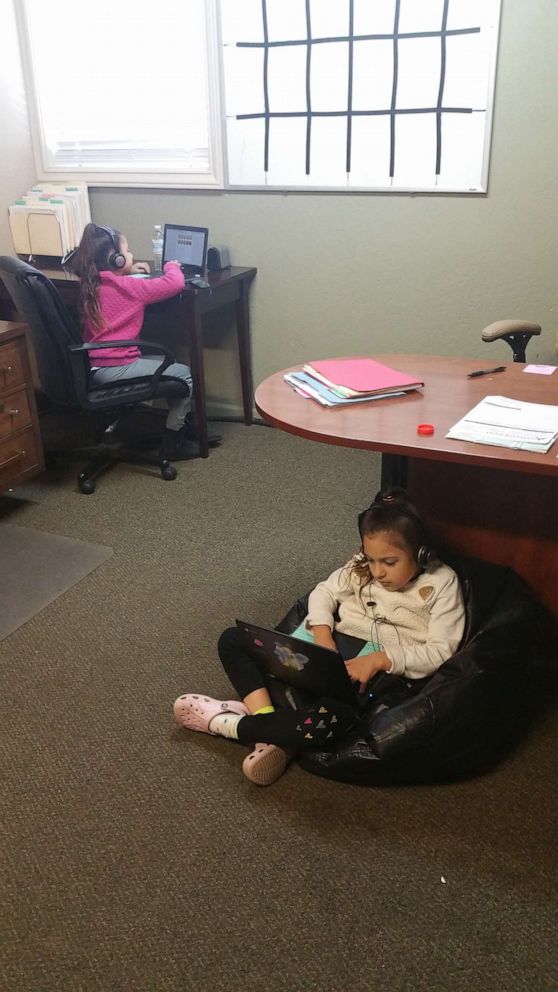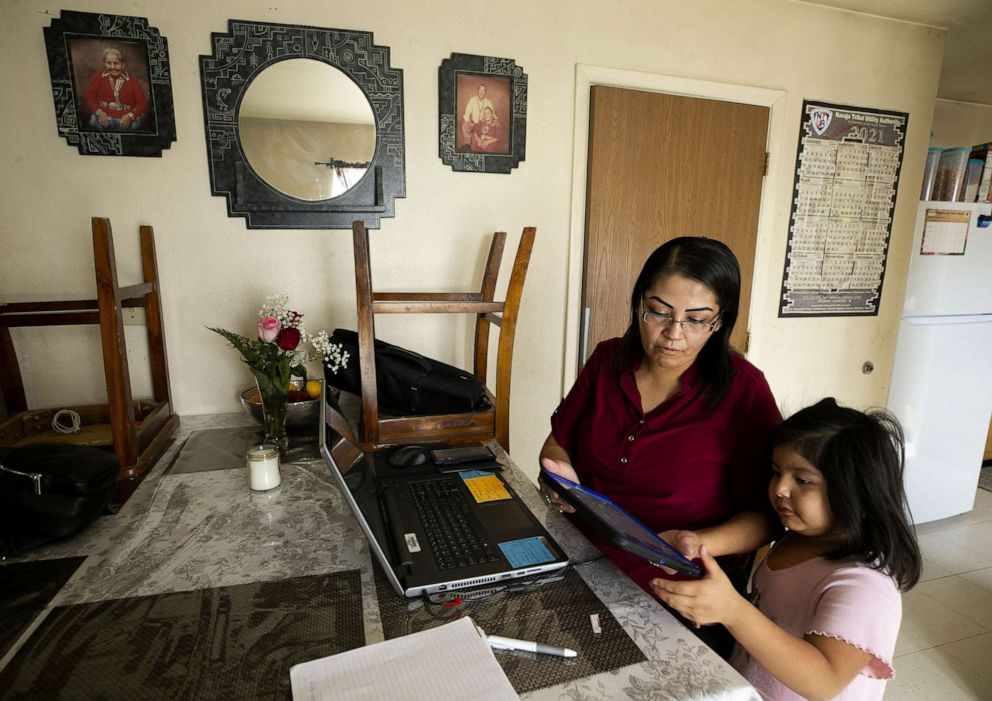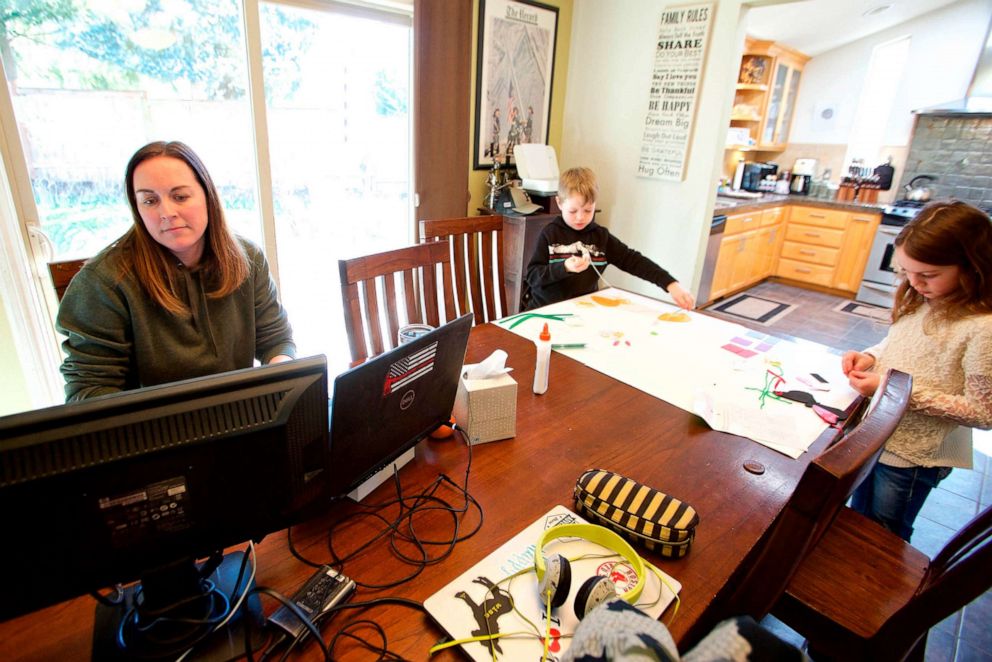This mom's 3 kids learn remotely at her job. Here's how employers can support women.
In 2020 alone, more than 2 million women left the workforce amid the COVID-19 pandemic -- and experts say more could follow, though employers can help lessen the blow as many schools and offices continue to operate remotely.
Ana Rodriguez of San Lorenzo, California, is mom to Christian, 13, Alanna, 7, and Alenna, 6, who attend San Lorenzo Unified School District. Rodriguez said the schools have adopted a virtual learning model since March 2020.
Rodriguez is a senior administrator at ArborTech Tree Care--a tree and landscaping installation company located in Hayward. Rodriguez said her business is essential and that when the pandemic hit she had to decide whether to quit her job, or stay home with her kids.
"[Quitting] wasn't an option for me," Rodriguez told "Good Morning America." "I said, 'I will make it work because that's who I am as a person.' "I didn't want my husband to be financially responsible for everything."
Rodriguez said she approached her employers to let them know her children's schools shut down. They agreed to allow Rodriguez's children attend virtual school inside the office building.
"They said 'Ana, if you can figure out what you need to do, we will support you with what is necessary,'" Rodriguez said of her bosses.
Rodriguez said she's grateful for the work-life flexibility, though she knows not every woman has employees who are willing to accommodate.
Are mothers being held to a a pre-pandemic standard at work?
In what is being called a "female recession," women are being hit hard as they face difficult times while they juggle family and career.
Women ages 25 to 44 are almost three times as likely as men of the same age group to not be working due to child care demands, according to research from the U.S. Census Bureau and Federal Reserve.
In December 2020, one single mother was working at an animal rescue farm in upstate New York. When schools closed in March, child care became an issue and she had to quit her dream job and move across the country, back to her hometown in Chino, California, so her mother and grandmother could help with child care.

"It was a very sad day. I really took what I was doing seriously, and I really wanted to be there," the mother, Katie Morales, told ABC's Nightline at the time.
"You could say it's a personal choice, but it doesn't feel like one," Morales said.
In July 2020, a California insurance account executive who was working from home amid the COVID-19 pandemic said that she was let go from her job over her kids being noisy while she was on work calls. Drisana Rios decided to sue her former employer for gender discrimination and wrongful termination.
The mom of two alleged that pandemic closures left her with no child care options. She said she was juggling children's lunches, nursing and nap schedules while trying to work at the same time.
"I'm meeting the deadlines, I'm working so hard," Rios of San Diego, told "GMA" last summer. "There's times when I'm working at night too, to make up for anything that needs to be done for the next day.
Making it work
For Rodriguez, her husband (a senior recruiter), works from home. Sometimes they switch off, and he will monitor the kids' remote schooling while Rodriguez heads to the office.
Rodriguez admitted that most of the child care has fallen on her, though her job lends itself more to being a parent amid COVID-19 than her husband's does, she said.
"For his job right now, it's real sensitive," Rodriguez explained. "The best thing to do is, I'll just take them with me. I don't have a calendar, I don't have a team. The office is run according to my schedule. My husband doesn't have that luxury."

Rodriguez said that in addition to employers, school administration should also offer more support on what works best for parents.
Rodriguez said there should be a meeting or questionnaire where parents are asked, "What is your situation and how can we assist you?"
"Where was our voice in this whole setup?" Rodriguez said. "The pandemic, it forced women to choose between [our families] and our careers ... it put us 50 steps back in how we're viewed in society. How are you going to be a teacher's assistant, a parent and work full time?"
"I personally was not going to give up my job and I made a choice, I had to make it work. And I'm still figuring it out," she added.
'We're going to reshape work': 5 ways to help women
"If you were going to push a panic button, now is the time," Lareina Yee, chief diversity and inclusion officer for McKinsey and a co-author of the consulting firm's 2020 Women in the Workplace study, said of the state today of women and the labor force, which more than 2 million women have left since the start of 2020.

While the labor force participation rate for men is about 2.6 percentage points below its pre-pandemic level, the participation rate for women is four percentage points lower, the lowest its been in more than three decades, according to the Brookings Institution, a nonprofit public policy organization.
During the pandemic, women, and especially women of color, were confronted with the double whammies of both job loss and being forced to leave the workforce because they shouldered the burden of caregiving duties .
"We calculated, on average, it's three hours of additional work duties a day at home for women, so if you add a full-time job plus 15 to 20 hours a week, that's a job-and-a-half," said Yee. "When working moms especially say, 'I'm doing so much. I'm so exhausted,' it's not surprising."
Working moms total about 23.5 million in the U.S., or nearly one-third of all employed women, according to Census data shared in May.
For many women, the news of more people being vaccinated across the U.S., more schools returning to in-person learning and more employers starting to discuss a return to in-person work is a light at the end of a very long and bleak tunnel.
Yee and other experts say this moment in time, as things start to reopen, is critical for making sure the world gets back to a new normal with women top of mind.
"We could let this all play out and have an extreme gendered recession, significantly lose representation of women of color in particular, of working moms and just take ourselves backwards a decade on progress in the workplace around gender equality," said Yee. "Or as we return to work, we can say, we're not going to snap back to how we worked before. We're going to reshape work."
Getting women back into the workforce matters not just because of the talent and representation they bring to the table, but because of the long-term consequences to women's finances, which can trickle down generations.
"On the micro level, every year a woman is out of the workforce she loses not just the salary of that year but she loses long-term earning power, retirement benefits, all kinds of downstream effects," said Tami M. Forman, chief executive of Path Forward, a nonprofit organization that creates mid-career internship programs for people who have stepped out of the workforce. "It diminishes her financial security for the rest of her life."

"At the macro level, it makes it hard for women to advance within companies," she said. "They lose not just those years of earning power but, those years of advancement, of bigger and better jobs."
"That's where you end up with situations where the whole senior team is eight guys and two single women who don't have children. That's not I think the world we all want to live in," said Forman.
Here are five tips from Forman and Yee to transform workplaces into places where women and men will return and succeed equally.
1. Make family-friendly policies for both women and men.
Both Forman and Yee stressed that any new policies implemented by employers should be targeted at all sexes so as not to reinforce gender stereotypes.
"The best companies will not frame them as women's programs but as people's programs," said Yee. "Our caregivers are men and women. Our caregivers are LGBTQ+, people of color, white males over 50. Our caregivers are talents in our organizations."
Speaking specifically of men's roles outside the office, Yee added, "One of the things you can't see in the data as easily is the number of men who are in dual-career households. There are a lot of men juggling a lot of responsibilities right now who need this just as much, if not more."
Forman said companies and leaders need to be aware of both how new options are being used by males and females and how well they, as leaders, are setting an example.
"If it's only women who are doing work from home in the future and men are in the office, are they getting better assignments?," she said. "Executives need to be thoughtful about that. And I do think male executives can and should model better gender equity behavior in their lives."
2. Allow for flexible work locations.
As millions of workers have made their home their office for the past year, a "silver lining" of the pandemic has been that workers have proven that flexible work options work, according to Yee.
"The number one thing is we've proved that you can have the same level productivity and not work in the office five days a week," she said. "So why do you have to work in the office five days a week? How about giving men and women the flexibility to be hybrid, the idea that maybe you're in the office two days a week and you're working from home three days a week."
Yee said workers have proven over the past year that they can work not only outside the office but also in different cities and states than their colleagues. Employers who acknowledge that can capitalize on it to diversify their talent pool, according to Yee.
"What if you said, 'We could use this return to work to source talent from different places in the United States?,'" she said. "We know that 60% of the Black worker population for example, both men and women, is concentrated in 10 states, and those states aren't always the places with, for example, high-tech jobs, but you could source that talent."
3. Evaluate and reward work differently.
Along with the flexibility of where they work, workers, especially working mothers, during the pandemic have also proven that flexible schedules, or time shifting, work, according to Yee.
"You can do the same amount of work and time shift that during the day to be able to do all the things that you need to do to be able to balance your home life and your work life, again, at no drop in productivity," she said. "It doesn't have to be where someone is watching you from nine to six and you're physically at your desk."
With that, employers should rethink how they are evaluating and rewarding their employees, and focus on outcomes over input, noted Forman, who explained that she wants to see executives be more "thoughtful about who does and doesn't get rewarded in the workforce and why."

"Rewarding people for overwork is the wrong thing to reward people for," she said. "This is a moment in time where we can think about how we do that differently and prioritize rewarding people for results.
"The remote environment promotes that because already time spent in a seat is not as interesting," Forman added. "It becomes harder and harder to measure."
4. Take the stigma out of a gap in a resume.
The pandemic should squarely erase the stigma that has long existed for women who took time off from their careers to care for children or other family members, according to Yee.
"If a college student takes a gap year, we don't worry that they'll be able to get through their calculus and biology 101 classes. Their brains are just as much intact, and if anything they're stronger and better," she said. "That's the same thing for women."
"If they've taken a year or so off and because of the pandemic they had to put their families first, that's not a story they need to put in the back closet," Yee said. "That is actually part of the reason why they are now looking and they're just as capable as they were before they left."
In order to take remove the stigma of the motherhood gap, and to recruit more women of color, who have been disproportionately hit hard by the pandemic, employers need to reimagine their hiring processes, according to Forman, who notes that bringing women back into the workforce is "not going to happen by accident."
"[Employers] need to create an environment where [hiring managers] can do something that's a little bit different than what they've done before when it comes to hiring," she said ."There are all different categories of people who find barriers to the workforce because they don't fit our typical view of what a worker is."
"Executives need to embrace the idea that it's part of their job as leaders to say, 'We're not going to just keep hiring the people we've always hired. We're going to do something different and I'm going to try to help make that possible for you,'" she said.
5. Focus benefits on mental health, child care.
The pandemic recession has shone a spotlight on both the child care crisis in the U.S. -- as many working mothers were left without options when schools turned to remote learning -- and the mental health crisis, as more than half of U.S. adults have reported their mental health has been negatively impacted due to worry and stress over the pandemic.
Though there are actions that need to be taken at a public policy level on both issues, employers can and should offer solutions too, according to both Yee and Forman.
"I certainly think that child care benefits should be as high a priority for big tech companies as the ping pong table is -- I'd like to see that happen -- but if child care is only available to employees who also have ping pong tables, it's not a lot of people," said Forman. "What we just realized is the school system is a major piece of child care infrastructure and we should think differently about how we structure that and what kinds of programs we have for working parents to be able to have their kids safely somewhere for the whole work day and the whole work year."
"Companies should look around and go, 'If the public school system offered more opportunities for kids to do enrichment in the afternoon, for example, as a standard part of their offering, that would be good for our employees, and good for everybody else too,'" she said.
When it comes to mental health, Yee said companies are increasingly looking at their employees as "whole people," and should continue to do so. Her "Women in the Workplace" study found that during the pandemic, a majority of employees named mental health and stress as a top job concern, second only to furloughs and layoffs.
"What's fascinating to me is that in the last handful of years, talking about mental health was not a topic you would hear in the executive team as a big point of discussion, but it has now become a really big imperative for so many companies," she said. "Paying attention to wellness as a capability for a healthy workforce is part of what corporations need to think about."






